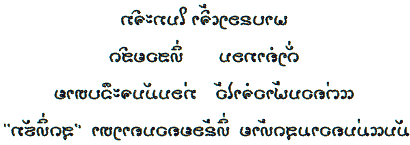Lao love poem
ກະຈົກ
ພາບຂອງເຈົ້າ ໃນກະຈົກ
ດັ່ງຄໍາກອນ ທີ່ສວຍສົດ
ແຕ່ຄວນຟ້າວຈໍາໄວ້ ກ່ອນມັນຈະລຶບຫາຍ
ມັນແມ່ນຄວາມສຸດທ້າຍ ທີ່ຂ້ອຍຄວນຄາງຫາ ‘’ສຸດທີ່ຮັກ’’!

With the Ariyaka script
kaCok
PabKongCao naikaCok
dangKoakon fisuanysod
aet Kuan Pav Coauaai kon man CaluBai
manaemn Kuaamsudfai fiKony Kuan KanGa sud fihak
Romanization
Kachok
Phabkhongchao naikachok
Dangkhoakon thisuanysod
Aet khuan fav choauaai kon man chalubhai
Manaemn khuaamsudthai thikhony khuan khangha "sud thihak"

→ French poem ←
Two small slanted eyes & Lao
The love poem (ຄວາມຮັກບົດກະວີ) translated into Lao, a language of the Thai group spoken in Laos and in some neighboring countries. With the diaspora, there are 40 million speakers.
Your pretty hat, has always surprised me, it is round with a small cone at the top. I can not, and i dont want to dissociate it of you! This Lao poem is also, the poem of your two small slanted eyes that shine during the night in the Vientiane jungle.
Lao (names that you coul find : Laotian, Vientiane, Savannakhet, Lao-Khrang, Rong Kong, Lao-Noi, Tai Lao, Eastern Thai, Lao-Tai, Lao Kao, Phou Lao, Luang Prabang, Lao-Lum, Lao Wiang, Wiang Jan, Lao-Kao, Laotian Tai, Lum Lao, Suwannakhet, Pakse, Autonym : (ພາສາລາວ)), very close to Thai, is a monosyllabic tonal tongue, with some polysyllables usually borrowed from Khmer and Pali.
The Lao alphabet is derived from the Siamese alphabet. I have not yet managed to transliterate the 4 small lines of the poem. But, perhaps, it is not necessary, considering the beauty of these signs!
Laotian literature
Ancient Lao literature is closely related to the Thai literature. The first texts in Lao are through the jataka a collection of stories about the previous lives of Buddha. One finds also other isolated jataka for example the Sinjaya, a poetic work of 2500 verses. Among this kind of poetry, long poem or novel in verse, we note for instance: Lin-thong, Kalahet, Thao Be, Pha Lak-Pha Lam. Besides moral tales that can sometimes be written in the form of poems, one also find tales to laugh.
The oral literature diffused by hmo-lam (bards) also takes the form of poems on love courses, on history, or on epic subjects; In general these poems, in small verses, are alternating, a man accompanied by an instrument, and replicas given by a woman.
One finds all this anonymous literature engraved on leaves of latanier and then transmitted by copyists of the Buddhist monasteries.
It is only in 1930 that Laos, after to be called Siam, underwent a revival, with the Thai poets Panai, Duang-Campa, and Leng-Phu-Pha-Ngon.